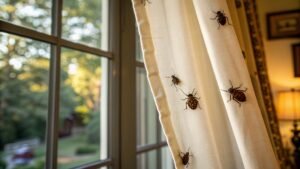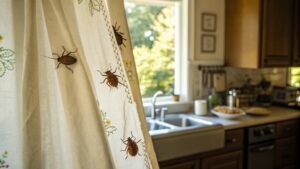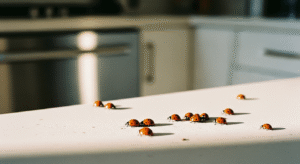Effective Ant Control: Protecting Pets and Kids at Home
Ant infestations can disrupt daily life and pose risks to children and pets if not handled properly. Homeowners in the Atlanta, GA metro area need ant-control solutions that are both highly effective and family-friendly. This article offers step-by-step guidance on safely identifying ant pathways and nests, eliminating ants with natural and store-bought treatments, and implementing long-term prevention measures through reliable services.
Identifying Ant Pathways and Nests Without Risking Family Safety
Identifying ant trails and nests safely is essential. Homeowners can locate entry points, determine infestation origins, and plan targeted removal while protecting vulnerable family members.
Securely Tracing Ant Trails Back to Their Origin Point
Observe well-worn paths near baseboards or window sills and use a bright light in dim areas to follow trails. This method avoids toxic substances and minimizes disturbances around children and pets.
Locating Common Indoor Ant Shelters With Care for Children and Animals
Common shelters include gaps behind appliances, cracks in concrete walls, or areas near water. A diluted vinegar spray can reveal hidden trails safely when used in low-traffic zones.
Recognizing Outdoor Ant Colony Indicators Through Safe Observation
Look for small soil piles, disturbed mulch, or nests under rocks. Regular, careful checks with a soft brush help plan treatments without resorting to harsh chemicals near play areas.
Distinguishing Ant Varieties for Targeted, Secure Removal Strategies
Different species, such as carpenter ants and Argentine ants, require distinct removal procedures. A magnifying tool helps safely identify species, ensuring appropriate, low-risk treatments.
How Can I Effectively Eliminate Ants Without Harming My Pets or Children Using Natural Approaches
Natural ant control methods use safe, commonly recognized ingredients that deter pests without toxic risks. These methods often rely on kitchen items and plant-derived solutions.
Employing Common Kitchen Items Like Vinegar or Lemon Juice for Ant Management
Mix equal parts water and vinegar in a spray bottle to disrupt pheromone trails. Lemon juice works similarly by altering the pH of ant paths and is safe in small accidental ingestions.
Spreading Diatomaceous Earth Safely in Homes With Young Ones and Animals
Food-grade diatomaceous earth damages ant exoskeletons mechanically. When applied in low-traffic areas, it reduces ant populations while posing minimal risk to children and pets.
Using Plant-Derived Oils as Ant Deterrents With Appropriate Safeguards
Essential oils such as peppermint, eucalyptus, and tea tree oil disrupt ant communication. A few drops mixed with water and sprayed on entry points creates a safe repelling barrier.
Preparing Homemade Ant Bait Solutions With Family Safety Foremost
A mixture of sugar and borax dissolved in water lures and kills ants. Place the bait in tamper-proof containers or inaccessible locations to prevent accidental ingestion by children or pets.
Applying Hot Water to Outdoor Nests Situated Away From Family Activity Zones
Pouring hot water directly into outdoor nests can rapidly reduce colonies. Ensure that the application area is far from family play zones to avoid accidental harm.
Effective, Safe Ant Control Strategies to Protect Kids and Pets
For persistent infestations, store-bought ant treatments offer an alternative when used carefully. It is critical to read labels and follow precautions to protect children and pets.
Carefully Reviewing Labels for Pet-Considerate and Child-Considerate Ant Killers
Always check labels for warnings and suitability in environments with kids and pets. Products labeled as non-toxic or safe for indoor use are preferable, and following instructions is essential.
Knowing Different Kinds of Secure Ant Bait Stations and Traps
Sealed bait stations and traps are designed to attract ants while limiting exposure to non-target species. Their secure design helps reduce ant populations safely in family areas.
Correctly Positioning Commercial Ant Solutions Out of Reach of Children and Animals
Apply treatments in high-traffic or concealed locations and store products on elevated surfaces or within locked cabinets. This careful positioning enhances safety as well as treatment efficacy.
Gel Baits Compared to Sprays Weighing Dangers and Advantages for Households With Youngsters
Gel baits target ants selectively with minimal risk of overexposure, while sprays cover broader areas. Gels tend to be safer for households with young children due to their measured application.
Gentle Ant Sprays Appropriate for Use Near Sensitive Household Members
Some ant sprays use botanical extracts and mild surfactants to deter ants without leaving harmful residues. Testing a small amount first ensures that sensitive individuals are not adversely affected.
How to Combat Ant Infestations for the Long Haul Through Child and Pet-Mindful Prevention
Long-term prevention relies on routine lifestyle and home maintenance adjustments to discourage ant entry and nesting. Regular practices ensure sustainable control.
Keeping a Clean Kitchen to Discourage Ants in a Safe Manner
Maintaining a debris-free kitchen by wiping countertops, storing food in sealed containers, and cleaning spills reduces ant attraction. This ongoing practice supports both pest control and home cleanliness.
Closing Off Cracks and Openings to Deny Ants Entry
Seal all cracks and gaps around doors, windows, and foundations with caulk or weatherstripping. Regular inspection and prompt repairs keep the indoor environment secure and ant-free.
Managing Pet Food Areas to Prevent Attracting Ants
Use sealed feeders and remove any uneaten pet food promptly. Regular cleaning of feeding areas minimizes ant attraction and reduces risks near children’s play zones.
Yard Upkeep Suggestions for Reducing Ant Colonies Outdoors Safely
Trim overgrown vegetation and remove debris regularly to minimize outdoor ant colonies. Keeping mulch and compost piles away from the house limits ant entry routes into living areas.
Teaching Household Members About Ant Prevention Habits
Educate everyone about the importance of cleanliness and prompt spill cleanup. Encouraging timely reporting of ant sightings contributes to a collective long-term prevention effort.
Managing Specific Safety Aspects for Infants, Young Children, and Different Animal Companions
Extra caution is required when treating areas near infants, young children, or sensitive pets. Adjust treatment methods to ensure no household member is exposed to harm.
Added Safeguards for Ant Management With Infants or Toddlers in the Home
Use only natural and food-grade products, and keep treatments out of reach. Barriers such as baby gates and close monitoring until products dry help protect toddlers.
Shielding Inquisitive Cats From Dangers of Ant Treatments
Cats may explore treated surfaces; thus, using enclosed bait stations and avoiding sprays in areas frequented by cats is recommended. Closely supervising outdoor access further minimizes risks.
Confirming Dog Security Throughout Ant Removal Procedures
Dogs are curious and may investigate unusual smells or tastes. Secure all products in locked cabinets, monitor canine behavior closely, and rinse paws if needed after treatment.
Points for Bird, Reptile, and Small Mammal Owners During Ant Management
Owners of birds, reptiles, and small mammals need to isolate treatment areas and provide alternative safe zones. Consult a veterinarian to tailor pest control plans for these highly sensitive companions.
Steps to Take Following Accidental Exposure of a Child or Animal to Ant Treatment
In case of accidental exposure, immediately remove the child or pet from the area and rinse any exposed skin with clean water. Seek medical or veterinary advice if irritation or lethargy occurs.
Determining When to Engage Pest Management Professionals for Ants and Confirming Their Safe Methods
If DIY methods fail, professional pest management may be necessary. It is important to know when to call experts and understand the safe protocols they use.
Spotting Indicators That Do-It-Yourself Ant Management Is Insufficient
If there is persistent activity, large colonies, or continuous re-infestations, it is likely time for professional help. Experts can inspect and treat hidden nests and complications beyond standard treatments.
Inquiries for Pest Management Services Regarding Their Family-Oriented Practices
Before hiring a service, ask about their safety methods around children and pets, including the chemicals they use. Companies like urban pest control prioritize non-toxic methods and minimal home disruption.
Learning About Integrated Pest Management (IPM) for More Secure Ant Treatments
IPM uses a combination of biological, cultural, physical, and occasional chemical methods to reduce ant populations. Inquire if professionals follow IPM to ensure reduced chemical reliance and enhanced safety.
Readying Your Residence for an Animal-Safe Professional Ant Service
Prepare by securing pets and children in a safe room, removing food items from treatment areas, and informing technicians about sensitive zones. This preparation aids effective and safe professional treatment.
Safety Procedures After Treatment in Homes With Children and Animals
After treatment, ventilate your home well and adhere to any post-treatment instructions. Keep children and pets away until the area is confirmed safe, and conduct follow-up inspections to maintain a secure, ant-free environment.
Frequently Asked Questions
Q: What natural methods can reduce ant infestations safely? A: Methods such as diluted vinegar sprays, diatomaceous earth, and essential oil mixtures help deter ants without toxic exposure to children or pets.
Q: How can store-bought treatments be used safely around kids and pets? A: Read labels for pet- and child-safe warnings, use bait stations, and place products in areas inaccessible to vulnerable family members.
Q: When should a homeowner seek professional pestmanagement? A: If standard methods fail or large colonies persist, professional intervention using IPM practices is recommended.
Q: Can ant prevention tips work long term in busy households? A: Yes, ongoing cleaning, sealing entry points, and proper food management help maintain an ant-free environment.
Q: What steps should be taken if a child or pet is accidentally exposed to ant treatments? A: Immediately remove the affected individual from the area, rinse any exposed skin with water, and consult a doctor or veterinarian if symptoms occur.
Final Thoughts
Urban Pest Control’s approach ensures effective ant management while safeguarding children and pets. By combining natural and professional methods, the strategies here address both immediate threats and long-term prevention. Through accurate identification of ant trails, the use of safe treatments, and consistent preventive measures, families can restore comfort and security to their homes. This guide serves as a dependable resource for managing ant infestations while keeping loved ones safe.



